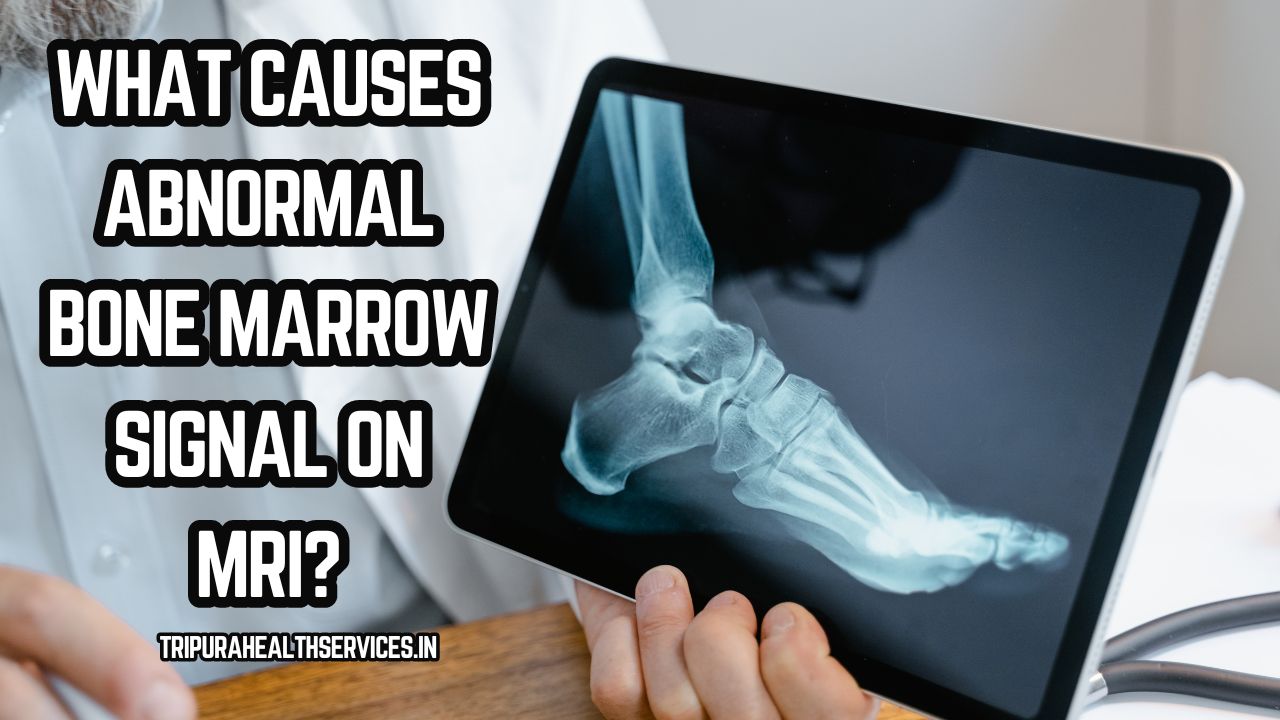What Causes Abnormal Bone Marrow Signal on MRI: Unraveling the Underlying Causes

What Causes Abnormal Bone Marrow Signal on MRI? Magnetic Resonance Imaging (MRI) has transformed medical diagnosis by delivering precise information about the human body.
Abnormalities in signal patterns on an MRI can raise concerns about the underlying health of our skeletal system when it comes to evaluating bone marrow.
In this blog post, we’ll take a look at the many reasons that can cause aberrant bone marrow signals on an MRI. We’ll look at the complexity of interpreting these signals and their significance in the field of medical imaging, from benign changes to potentially catastrophic disorders.
Understanding the Basics of Bone Marrow and MRI

Let’s start by exploring the basics of bone marrow and the role of MRI in visualizing its structure.
The Role of Bone Marrow in the Body:
Bone marrow, a critical component of the human skeletal system, is a dynamic and essential tissue with multiple functions. Bone marrow is found within the cavities of bones, mainly in long bones such as the femur and sternum, and plays an important role in the formation and maintenance of blood cells.
It is divided into two types: red and yellow marrow, and it responds to the needs of the body throughout life. The principal site for hematopoiesis—the generation of blood cells—in early development is red marrow.
It produces red blood cells (which transport oxygen), white blood cells (which fight infections), and platelets (which aid in blood clotting).
Red marrow undergoes a metamorphosis as the body matures. The quantity of red marrow reduces, making way for yellow marrow, which contains a high concentration of fat cells.
While yellow marrow is less involved in active blood cell generation, it is nevertheless a significant source of energy and helps the skeletal system function properly.
In essence, bone marrow functions as a dynamic factory, directing the generation of blood cells required for survival and the maintenance of the body’s delicate equilibrium. Its complicated activities highlight the critical role bone marrow plays in the general health and functionality of the body.
How MRI Captures Bone Marrow:

MRI uses powerful magnets and radio waves to capture precise images of bone marrow. This non-invasive imaging approach takes advantage of the magnetic characteristics of hydrogen atoms found in the body, notably those found in water and fat molecules plentiful in bone marrow.
To visualize bone marrow, T1-weighted and T2-weighted MRI sequences are widely used.
T1-weighted pictures emphasize changes in tissue structure, exposing variations in fat and water content, whereas T2-weighted images focus variations in water content, assisting in the diagnosis of abnormalities such as inflammation or edema inside the bone marrow.
This sophisticated method allows for a thorough examination of bone marrow composition and any anomalies.
Common Causes of Abnormal Bone Marrow Signals on MRI:

Changes in Fat Content: Normal aging can cause changes in bone marrow composition, including an increase in fat content. This is frequently recognized as hyperintensity on T1-weighted imaging, which is regarded as a harmless and common variant.
- Changes in Hematopoietic Function: Conditions that impair blood cell synthesis, such as anemia or myeloproliferative disorders, might alter bone marrow signaling. MRI may reveal increased cellularity or aberrant cell types.
- Inflammatory Conditions: Osteomyelitis, or bone marrow inflammation, can cause aberrant signal patterns. Hyperintensity on T2-weighted images can be caused by infections or inflammatory illnesses.
- Trauma or stress fractures can cause bone marrow edema, which causes changes in signal intensity. On fluid-sensitive sequences, this is frequently recognized as hyperintensity.
- Multiple myeloma and leukemia, which are characterized by the invasion of aberrant cells into the bone marrow, can induce diffuse alterations in signal intensity on MRI.
- Certain metabolic diseases, such as Gaucher’s disease or sickle cell anemia, can have an effect on bone marrow signaling. These changes could be a sign of underlying metabolic issues.
Significance and Diagnostic Considerations:
The interpretation of aberrant bone marrow signals on MRI is crucial in clinical diagnoses. While some alterations are natural aging or minor injuries, others may indicate underlying pathologies such as hematological disorders, infections, or infiltrative diseases.
Diagnostic considerations go beyond imaging alone, needing a multifaceted approach that includes patient history, symptoms, and, in many cases, further diagnostic testing.
Clinical correlation is critical for accurate interpretation, since it ensures that MRI findings are consistent with the patient’s general health situation.
The importance is in the ability to detect abnormalities early, guide appropriate treatment strategies, and provide valuable information for healthcare providers to provide personalized and targeted care, emphasizing the importance of collaboration between imaging specialists and the broader healthcare team.
FAQs About what causes abnormal bone marrow signal on MRI?
Q1: Can abnormal bone marrow signals on an MRI be a normal part of aging?
A1: Yes, alterations in bone marrow signals, such as increasing fat content, can be considered typical as we age. However, it is critical to differentiate between age-related changes and aberrant signals linked with underlying medical disorders.
Q2: What are the common symptoms associated with abnormal bone marrow signals?
A2: Symptoms can differ depending on the underlying cause. Unexplained discomfort, weariness, anemia, and susceptibility to infections are also common symptoms.
However, aberrant signals can be asymptomatic and identified by chance.
Q3: Are all abnormal bone marrow signals on MRI indicative of serious medical conditions?
A3: No, not all aberrant signals indicate the presence of a dangerous ailment. Changes in bone marrow signaling can be caused by benign changes such as aging, slight trauma, or inflammation. Clinical connection is essential for proper interpretation.
Q4: Can an MRI differentiate between benign and malignant causes of abnormal bone marrow signals?
A4: To some extent, yes. Although MRI can provide information about the nature of abnormalities, final diagnosis frequently necessitates additional testing and clinical correlation.
Patterns of malignant causes, such as leukemia or multiple myeloma, may be unique.
Q5: How is abnormal bone marrow diagnosed and treated?
A5: Imaging (MRI), clinical examination, and sometimes bone marrow sample are used to make a diagnosis.
Treatment is determined by the underlying cause and may involve antibiotics, inflammation management, or the initiation of hematological diseases medicines.
Q6: Can trauma or injuries cause abnormal bone marrow signals on MRI?
A6: Yes, trauma or stress fractures can cause bone marrow edema, which causes changes in MRI signal intensity. These alterations are frequently temporary and are associated with the healing process.
Q7: Are there lifestyle factors that can influence bone marrow signals on MRI?
A7: Lifestyle factors such as nutrition and overall health can have an impact on bone marrow composition. Significant irregularities, on the other hand, are frequently connected with medical issues rather than with lifestyle alone.
Q8: How often should individuals undergo MRI for bone marrow assessment?
A8: The frequency of bone marrow MRI examinations is determined by personal health factors and specific medical issues. It is usually advised based on clinical necessity and medical advice.
Q9: Can abnormalities in bone marrow signals be reversible?
A9: Yes, in some situations. With the right treatment, benign alterations caused by inflammation or damage may be reversed. However, irreversible alterations caused by certain disorders may necessitate continuing management.
Q10: Are there risks associated with undergoing an MRI for bone marrow assessment?
A10: MRI is generally thought to be safe. Individuals with particular medical disorders or metal implants should notify the MRI technologist, and claustrophobia may be taken into account.
Conclusion:
Finally, aberrant bone marrow signals on MRI can be caused by a variety of factors, ranging from normal age-related changes to more complex medical disorders. Because of its potential to provide precise insights into the composition of bone marrow, MRI is a helpful diagnostic tool.
However, to guarantee accurate diagnosis and quick intervention when necessary, imaging professionals and healthcare practitioners must work together to interpret these signals.
Our understanding of aberrant bone marrow signals adds to improved patient care and treatment methods as we continue to uncover the secrets of medical imaging.
- Your Ultimate Guide to Travel Insurance for Adventure Sports
- A Guide to Renters Insurance for Pet Owners: Pet-Proof Your Policy
- Safeguard Your Future: Understanding Identity Theft Insurance
- Safeguard Your Event: Understanding Event Cancellation Insurance
- Everything You Need to Know About Critical Illness Insurance Riders
- Home Equity Loans vs. HELOCs: Which is Right for You?











